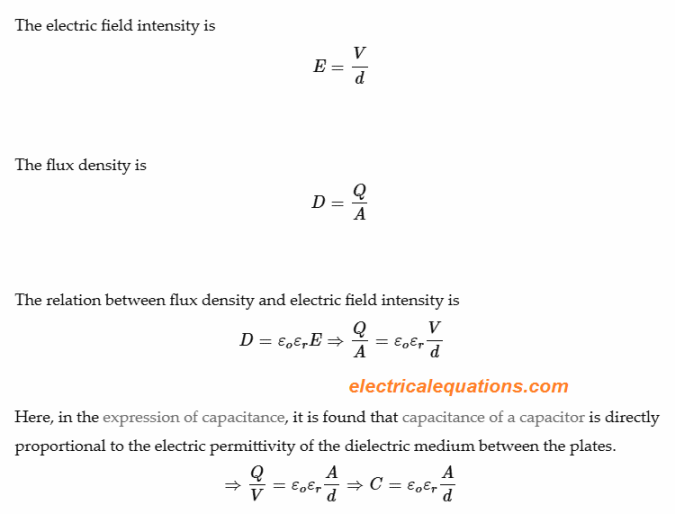If we put a pair of electrically charged elements close to each other they will likely exhibit some force between them.
This force may possibly be an attractive or be repulsive with respect to the characteristics of the charge of the bodies.
Two bodies with similar charge will repel one another while two dissimilar charged bodies will show attractive force between each other.
The magnitude of force operating on both of these neighboring bodies could be equated through the following Coulomb’s Law.

The force appearing among neighboring electrically charged systems is determined by primarily 3 aspects.
Magnitude of charge of the bodies Q1 and Q2 coulombs, meaning the product of charges on the bodies.
1) Distance between the center of the charges i.e. d meters.
2) The force will be inversely proportionate to the square of the distance d.
3) The medium where the bodies are located.
The purpose of permittivity is established in the 3rd point. It is observed that force operating among neighboring identically charged bodies at the uniform distance is unique across various mediums.
From the formula of Coulomb’s law, we realize that the force across neighboring electrically charged bodies is actually inversely proportionate to the expression εoεr .
Relative Permittivity or Dielectric Constant
This expression is known as permittivity of the medium. Here, εo is called the absolute permittivity of the vacuum and εr is the relative permittivity of the medium where the bodies are positioned.
Relative Permittivity can be described as the ratio of the real or absolute permittivity of a medium to the absolute permittivity of vacuum. If the permittivity of a medium is ε then

The ratio for air is 1.006. Implies that relative permittivity for air is 1.0006.

The electrostatic force between neighboring electrically charged bodies is inversely proportional to the permittivity of the medium. Therefore, the relative permittivity of a given medium is defined as the ratio of force operating between close by electrically charged bodies in the vacuum to the force operating between the same bodies at an identical distance in the given medium.


We know that intensity of an electric field over a given point in a field is defined as:

The above formula helps us to determine the expression of electrical flux density (D) at that point as:

D = εoεr E
From the above electrical field intensity and flux density formulas we can finally derive the following equation,
D/E = εoεr
It is apparent that the ratio of the electric flux density to the electric field intensity in a point in the field may be understood to be the permittivity of the medium at that point.
Let's assume a parallel plate capacitor having area A, separated by distance d and having permittivity ε for the plate dielectric. Then the charge built up in the capacitor will be Q caused by a voltage supply V across the capacitor.


Likewise, the formula for energy stored in the capacitor can be written as:
Energy = 1/2 CV2
By that formula, we are able to deduce that the energy residing in the capacitor will be directly proportional to permittivity of the medium between the plates.

Therefore both capacitance and the energy stored in the capacitor will be directly proportionate to permittivity of the dielectric medium.
For this reason permittivity of the medium applied for building a capacitor is an crucial element that establishes the proportions of the capacitor while developing a capacitor.
Absolute Permittivity
It is the measure of capacitance which is experienced during the formation of an electric field in a selected medium. Precisely , permittivity identifies the quantity of charge required to produce one unit of electric flux in a selected medium.
We will demonstrate it afterwards in this post. The absolute permittivity of any medium could be depicted by the multiplying two conditions that is absolute permittivity of vacuum multiplied by relative permittivity of the medium.
This is to get an easier calculation determined by permittivity. The absolute permittivity of vacuum is considered as the starting value of the permittivity.
The relative permittivity of a medium is the number of times the permittivity of the medium is higher than the absolute permittivity of vacuum.
Unit of Permittivity
Unit of Absolute Permittivity
Referring to the the Coulomb’s law formula, we can jot down the expression of permittivity as,
ε = Q1Q2 / F4 π d2
From the above shown expression of permittivity, we are able to establish the unit of permittivity as:

Alternative Unit of Absolute Permittivity
The relationship between permittivity of dielectric medium of a capacitor and capacitance can be written as:

Image

Permittivity of Free Space
The permittivity of free space is additionally recognized as vacuum permittivity. The magnitude of permittivity of free space is,Paragraph
ε ≈ 8.854187817620 x 10-12F / m
Leave a Reply